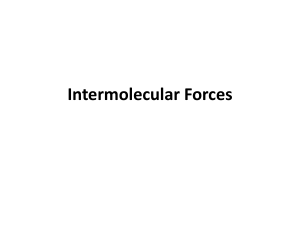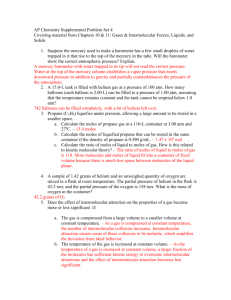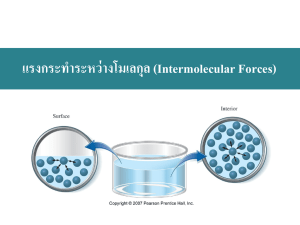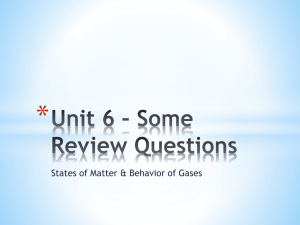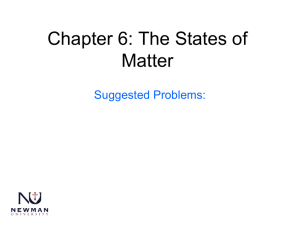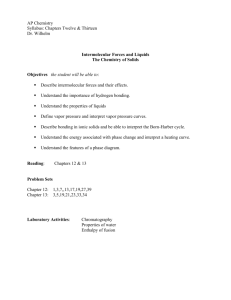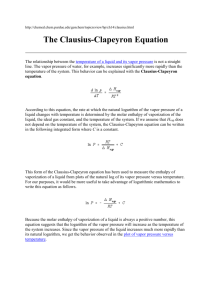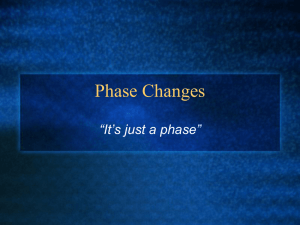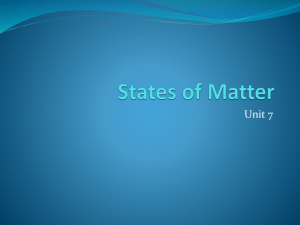Ch 11 Liquids
advertisement
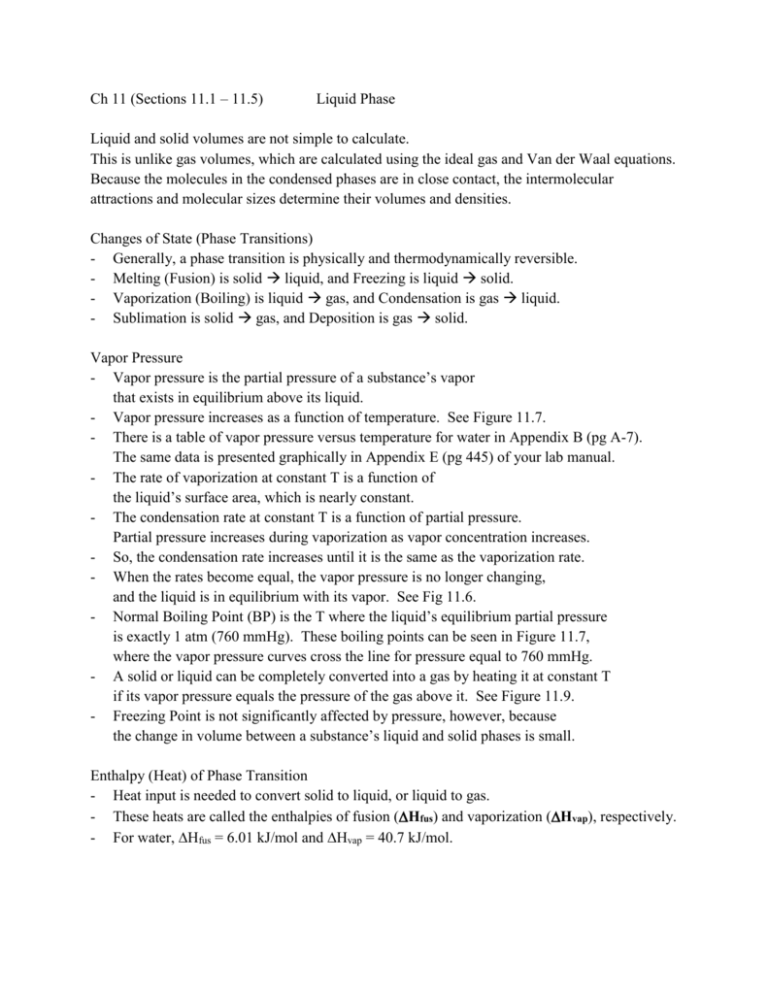
Ch 11 (Sections 11.1 – 11.5) Liquid Phase Liquid and solid volumes are not simple to calculate. This is unlike gas volumes, which are calculated using the ideal gas and Van der Waal equations. Because the molecules in the condensed phases are in close contact, the intermolecular attractions and molecular sizes determine their volumes and densities. Changes of State (Phase Transitions) - Generally, a phase transition is physically and thermodynamically reversible. - Melting (Fusion) is solid liquid, and Freezing is liquid solid. - Vaporization (Boiling) is liquid gas, and Condensation is gas liquid. - Sublimation is solid gas, and Deposition is gas solid. Vapor Pressure - Vapor pressure is the partial pressure of a substance’s vapor that exists in equilibrium above its liquid. - Vapor pressure increases as a function of temperature. See Figure 11.7. - There is a table of vapor pressure versus temperature for water in Appendix B (pg A-7). The same data is presented graphically in Appendix E (pg 445) of your lab manual. - The rate of vaporization at constant T is a function of the liquid’s surface area, which is nearly constant. - The condensation rate at constant T is a function of partial pressure. Partial pressure increases during vaporization as vapor concentration increases. - So, the condensation rate increases until it is the same as the vaporization rate. - When the rates become equal, the vapor pressure is no longer changing, and the liquid is in equilibrium with its vapor. See Fig 11.6. - Normal Boiling Point (BP) is the T where the liquid’s equilibrium partial pressure is exactly 1 atm (760 mmHg). These boiling points can be seen in Figure 11.7, where the vapor pressure curves cross the line for pressure equal to 760 mmHg. - A solid or liquid can be completely converted into a gas by heating it at constant T if its vapor pressure equals the pressure of the gas above it. See Figure 11.9. - Freezing Point is not significantly affected by pressure, however, because the change in volume between a substance’s liquid and solid phases is small. Enthalpy (Heat) of Phase Transition - Heat input is needed to convert solid to liquid, or liquid to gas. - These heats are called the enthalpies of fusion (Hfus) and vaporization (Hvap), respectively. - For water, Hfus = 6.01 kJ/mol and Hvap = 40.7 kJ/mol. Ex 11.1 Heat and Mass involved with Phase Changes - CCl2F2 (R-12) has Hvap = 17.4 kJ/mol and Mm = 121 g/mol - To find the mass of CCl2F2 which must vaporize (absorb heat) in order for 525 g of water to freeze (release heat), first calculate the heat that must be removed from the water. q = (moles H2O)(Hfus) = (525 g) ( 1 mol − 6.01 kJ )( 18.0 g - 1 mol ) = − 175.3 kJ This amount of heat must be absorbed by CCl2F2. Note the sign change. − q = (moles CCl2F2)(Hvap) The amount of heat can then be used to find the moles and mass of CCl2F2 needed. −q + 175.3 kJ moles CCl2F2 = = = 10.1 mol Hvap 17.4 kJ/mol mass CCl2F2 = (10.1 mol)(121 g/mol) = 1.22 × 103 g = 1.22 kg Clausius-Clapeyron Equation - This equation relates vapor pressure with the temperature in Kelvins (K). - By using the logarithm of pressure, a straight line with a negative slope results. 1 ln(P) = − (A)( ) + B A= - T Hvap and R = 8.31 J/K·mol (universal gas constant) R See the linear results in Figure 11.10. In this figure, ln(P) is the y variable and (1/T) is the x variable. Substituting for A, we get these results at temperatures T1 and T2: ln(P1) = [− ( ln(P2) = [− ( Hvap R Hvap R 1 ) (T ) + B ] 1 1 ) (T )+ B ] 2 - Subtracting the first equation from the second, we get: - ln(P2) − ln(P1) = [ − ( R ) (T ) + B ] − [ − ( R ) (T ) + B ] 2 1 When the B’s are cancelled, this reduces to: Hvap ln(P2) − ln(P1) = ( - Hvap R Hvap 1 1 ) (T – 1 1 T2 1 ) The logarithms can be simplified as well: 1 P ln(P2 ) − ln(P1 ) = ln(P2 ) + ln(P1 −1 ) = ln(P2 ) + ln (P ) = ln (P2 ) 1 - The final result is: 𝐏 𝐇𝐯𝐚𝐩 𝐥𝐧 ( 𝟐 ) = ( 𝐏 𝟏 𝐑 𝟏 𝟏 𝟏 𝟐 ) (𝐓 – 𝐓 ) 1 Ex 11.2 Find vapor pressure (P2) of water at T2 = 85 oC = 358 K. - Hvap = 40.7 kJ/mol P1 = 1.00 atm at the normal BP (T1 = 100 oC = 373 K). - ln ( P2 )= [ 1.00 atm - ln ( P2 1.00 atm P2 1 atm J mol J 8.31 K·mol 40700 1 ] [373 K − 1 ] 358 K ) = (4898 K)(− 1.123 × 10-4 K-1) = − 0.550 = ln-1(− 0.550) = e − 0.550 = + 0.577 P2 = (0.577 atm)(760 mmHg/atm) = 439 mmHg Phase Diagrams - Phase diagrams show graphically (P vs. T) when solid, liquid, and gas phases are stable, and where there are transitions from one phase to another. See the phase diagram for water (below left and in Figure 11.11). - At P = 1.0 atm, ice melts (s liq) at 0 oC and liquid boils (liq g) at 100 oC. - Gases are generally stable at low P and high T (bottom right). - Liquids are generally stable at high P and medium T (top middle-right). - Solids are generally stable at low T (left). - A triple point is the P and T where solid, liquid, and gas are all stable together. For water, the triple point is 0.006 atm and 0.01 oC, which is point A in Fig 11.11. - Line AB is the melting curve, line AC is boiling, and line DA is sublimation. - A critical point is the P and T where liquid and gas have the same density. Liquid and gas become indistinguishable if T > TCrit or P > PCrit. Beyond this point, the substance becomes a supercritical fluid. For water, this occurs at 374 oC and 218 atm (point C). - For CO2, the phase diagram (below right and in Fig 11.12) appears similar. But, 1.0 atm intersects the sublimation curve at −78 oC. Dry ice converts directly to gas above this T. - For sulfur, there are two distinct solid phases: rhombic and monoclinic crystals. As a result, there are three triple points for S. See Figure 11.12. Phase Diagram for H2O Phase Diagram for CO2 Surface Tension - Surface tension is the energy needed to increase a liquid’s surface area, expressed as J/m2. - A surface molecule feels a net force that is downward, and towards the bulk liquid, due to intermolecular attractions. See Figure 11.16. - The result is that these forces act to minimize the total amount of surface area for liquids. See the photos in Figs 11.17 and 11.18. Viscosity - Viscosity is a fluid’s resistance to flow. It is caused by intermolecular interactions. - Attractions between molecules, and the tendencies of long molecules to get tangled together, both cause viscosity to increase. - Gases typically have viscosities that are much lower than those of liquids. This occurs because gas molecules are much farther apart from each other, and therefore have far fewer intermolecular interactions. - A liquid with a low viscosity, like water, flows easily. - A fluid with a high viscosity, like motor oil, shears instead (and not all fluid flows together). The result is that high viscosity fluids tend to be slippery. Intermolecular Forces: Dipole-Dipole - Molecules with permanent dipoles (+ and −) are held together by their attractive forces. - Polar molecules align together, + of one molecule near − of neighboring molecule. - For HBr, the electronegativity (e/n) difference is 2.8 − 2.1 = 0.7. So, the molecule is moderately polar, with + H, and − Br. A + H on one molecule will be attracted to the − Br on a neighboring molecule. - A similar situation exists with HCl molecules. See Fig 11.21. Intermolecular Forces: London (Dispersion) - London forces are attractions between molecules due to instantaneous dipoles. - All atoms and molecules are instantaneously polar due to the random motion of e-1’s. - That is, the e-1 density can instantaneously (not permanently) be greater on one side of an atom than on the other. - This results in a weak attractive force between all molecules, whether polar or not. - Long-chain hydrocarbon molecules can twist around each other. This creates numerous contact points between atoms for their London forces. As a result, longer hydrocarbon chains have higher boiling points. Intermolecular Forces: Hydrogen Bonding - H-bonding is an especially strong polar attraction that occurs where an H atom is attached to an N, O, or F atom. - These H atoms are +, and they bond with the nearby N, O and F atoms, which are −. - See H-bonding for water in Fig 11.25. - CH3OH (methanol) can H-bond because it has a − O attached to a + H. However, the three H’s attached to the C are not + and cannot H-bond. Relative Strengths of Intermolecular Forces - The strength order for intermolecular forces is H-Bonding > Dipole > London. - As intermolecular forces increase, the vapor P will decrease, and the boiling point will increase. Ex 11.5 Strengths of Intermolecular Forces - CH4 (methane) is nonpolar, with only London forces. - CHCl3 (chloroform) is polar, with Dipole and London forces, but cannot H-Bond. - CH3CH2CH2CH2OH (butyl alcohol) has a + H and a − O. So, it possesses H-Bonding, Dipole and London forces. - The overall result for intermolecular forces is: CH3CH2CH2CH2OH > CHCl3 > CH4. Ex 11.6 Relation between Intermolecular Forces and Vapor Pressure - Vapor Pressures decrease as intermolecular forces increase and hold molecules together more tightly. - Carbon dioxide is nonpolar (London only). - Dimethyl ether has polar C-O bonds, but no + H (Dipole and London). - Ethanol has a + H and a − O (H-Bonding, Dipole and London). - Vapor Pressure trend is opposite of trend for strength of intermolecular forces. The molecule with the lowest amount of intermolecular forces has the highest vapor pressure. The overall result for vapor pressure is: carbon dioxide > dimethyl ether > ethanol.

